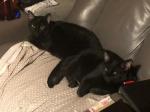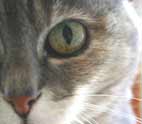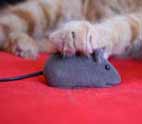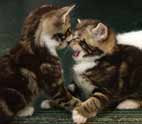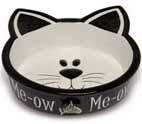Hairballs
A Cat Vomiting Problem
Cat Hairballs are something every cat owner has encountered one time or another. They can be a natural part of being a cat and are not necessarily an indication of any serious cat illnesses.
Our cat Mo always had her fair share of furballs over the years, although being a short haired cat the problem had been very infrequent and mild.
Long haired cats are not so lucky and my old Maine Coon cat Tigger was prone to some very nasty attacks of cat vomiting and chocking as a result of fur balls. We had to give him special medication every day to make them pass more easily.
So What Are Cat Hairballs and What Do They Look Like?
|
For the first-time owner, furballs can be something of a shock, especially as they don't actually look like a ball at all. To best describe them you would have to say they look like a dark coloured slimy sausage of matted cat hair. Depending on the amount of hair swallowed by your cat they can range in size. Little Mo's were about the size of my little finger, but Tigger's were much longer and thicker (this is a lovely subject isn't it?) Sorry for this picture (a little disgusting I know but it does give you an idea of what cat hair balls look like) |
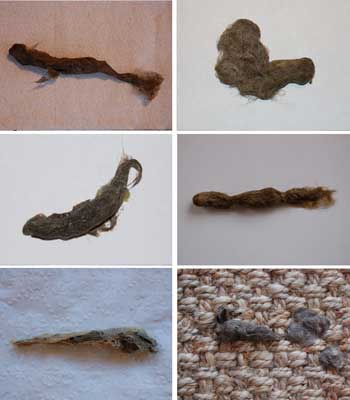 |
So Why Do Cats Get Fur Balls?
In the wild, a cat's fur coat will have different thickness's depending on the season. Their coat will naturally shed when the weather becomes warmer and thickens up again during the cold months.
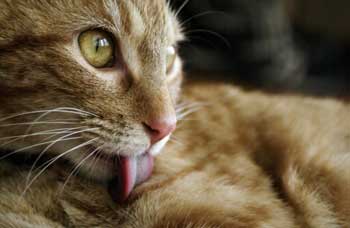
In the wild, the loose fur is more likely to fall off by itself and so requires less assistance from the cat. However, our domestic cats are now used to living indoors in more comfortable surroundings with central heating.
This unfortunately means that the fur coat does not shed at the usual seasonal times and is more likely to have a light shedding all year round.
To get rid of this loose hair cats will groom themselves and so be prone to swallowing more cat hair. This loose hair, if swallowed in large enough quantities, will be unable to pass through the intestines and so begins to form what we call a fur ball.
How Do I Know If My Cat Has Fur Balls?
Normally a hairball can be passed through the cat's digestive system and will pass out via the cat's faeces. In which case most cat owners would not be aware that there was one. Hoverer, if a fur ball becomes too large the quickest and easiest way for the cat to get rid of it is to vomit it up.
See my other pages all about cat illnesses for other causes of cat vomiting.
The first signs that your cat might be feeling a little unwell is when you see them eating grass, which means they are trying to make themselves sick.
Another indication that something is wrong is that your cat may stop eating for a day or so and may even start to retch a lot, without anything coming up.
Usually the cat will be able to regurgitate the furball by themselves after a few days.
If you see your cat vomiting, check to see what they have brought up and you may well see the furball in the vomit.
After which they are usually back to their old selves and famished. In some very rare cases the fur ball may become so stuck that the cat cannot vomit it up themselves, causing an obstruction in the gastrointestinal tract.
In these cases it will have to be removed by a vet surgically, thankfully this is a very rare.
Can Cat Hairballs Be Prevented?
Although there are no guarantees that your cat won't ever get a cat hair ball, there are certain things that you as an owner can do to reduce the occurrence and frequency of them. After all it can't be very nice for kitty to keep getting sick all the time.
Grooming - weekly (or in the case of longhaired cats, daily) brushing of your cat's fur to remove loose hairs with a brush is essential. The fewer loose hairs there are for your cat to swallow the better.
Make sure you use the right tools for your cats type of fur so that you can remove as many of those loose little hairs as possible. See my page about Cat Grooming.
Helping Your Cat Get Rid Of Hairballs
It is not always eay for our cats to bring up hairballs and sometimes they need a little help from us. Here are a few products I have used with my cats.
Pet Naturals Hairball (45 count)Dry Food Treats - There are some dry treats which contain lubrication to help to loose the hair so that it can either pass more easily through the intestines or allow for easier vomiting of the hair.
I prefer natural treats for my cats such as this one:
Hartz Hairball Remedy Plus Paste for Cats and Kittens, 2.5 Oz.
Lubrication - There are safe lubricating pastes available that help your cat to pass a particularly difficult hairballs. they taste nice for your cat too and so your cat will see it as a treat rather than medication.
We sometimes used to give Little Mo a helping hand with this type of medication. She loved it as you can get them in different flavours and after a short while the fur ball was always passed.
Seeds and Thngs SWEET BARLEY SEEDS FOR KITTY CAT GRASS 50 + GRAMS 1,000 SEEDS --- FRESH SEED
Cat Grass - Cats like to eat grass to help bind the hair together inside of them which also stimulates them to vomit.
However not every one has access to a garden or the right kind of grass. Luckily you can buy cat grass seed which you can either grow outside nor inside in containers for your cat.
So, if you see your cat vomiting or retching, don't panic. It may look very distressing and unpleasant but if it is caused by a furball, then this is a completely natural occurrence and your cat will soon recover once any hairballs have been passed.




